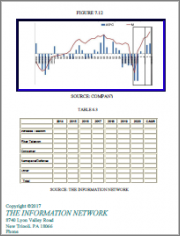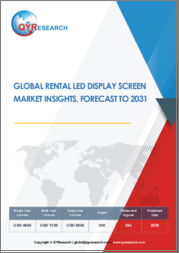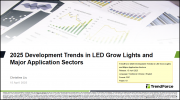
|
시장보고서
상품코드
1541179
세계의 고휘도 LED 시장 보고서 : 용도, 유통 채널, 실내외 용도, 최종 용도, 지역별(2024-2032년)High-Brightness LED Market Report by Application, Distribution Channel, Indoor and Outdoor Application, End-Use Sector, and Region 2024-2032 |
||||||
세계의 고휘도 LED 시장 규모는 2023년 277억 달러에 달했습니다. 향후 IMARC Group은 시장이 2032년까지 444억 달러에 이를 전망이며 예측 기간 동안 복합 연간 성장률(CAGR)은 5.2%가 될 것으로 예측했습니다.
고휘도 LED(HB-LED)는 높은 휘도를 가지며 더 많은 전류 레벨과 전력 소산을 견딜 수 있는 반도체로 만들어진 고급 LED입니다. 이 유형의 LED는 일반적으로 1와트 이상의 전력을 소비하고 50루멘 이상의 빛을 방출하므로 매우 밝은 광 출력을 얻을 수 있습니다. 기존과 비교하면 소비 전력을 최대 50%-70% 삭감할 수 있으므로 이산화탄소 배출량을 대폭 삭감할 수 있습니다. 이러한 LED를 사용하는 장점은 장수명, 조광성 향상, 효율성 등이 있습니다. 게다가 폭넓은 사이즈가 있어, 어떤 회로 유형에도 설치할 수 있습니다. 그 결과, 많은 조명 용도에서 표준 LED 조명기구를 대체하는 것이 증가하고 있습니다. 고휘도 LED는 표지판과 신호등, 관구 및 전구, 휴대폰 및 TV 디스플레이 등 다양한 용도로 사용됩니다.
고휘도 LED 시장 동향 :
이 시장을 견인하는 것은 주로 에너지 효율이 높고 내구성이 뛰어난 조명 솔루션에 대한 수요 증가입니다. 이 배경은 이산화탄소 배출량이 많다는 우려가 커지고 있습니다. 이 외에도 에너지 절약과 환경 친화적 인 건축을 지원하는 정부의 적극적인 노력이 시장에 탄력을줍니다. 게다가 노트북, 휴대전화, TV 등의 가전제품의 매출이 증가하고 있는 것도 시장에 밝은 전망을 가져오고 있습니다. 또한 지속적인 제품 혁신과 제품 출시, HB-LED 부품의 가격 하락이 시장을 견인하고 있습니다. 게다가 주요 시장 기업에 의한 합병,인수(M&A) 등의 성장 전략의 채용이 확산되고 있는 것도 시장을 뒷받침하고 있습니다. 기타 시장 성장 요인으로는 대중의 가처분 소득 수준 상승과 광범위한 R&D 활동이 포함됩니다.
이 보고서에서 다루는 주요 질문
- 세계의 고휘도 LED 시장은 지금까지 어떻게 추이하고 향후 어떻게 추이할 것인가?
- COVID-19는 세계의 고휘도 LED 시장에 어떤 영향을 미치는가?
- 주요 지역 시장은?
- 용도별 시장 분석은?
- 유통채널별 시장 분석은?
- 실내외 용도별 시장 분석은?
- 최종 용도 분야별 시장 분석은?
- 업계의 밸류체인의 다양한 단계란?
- 업계의 주요 촉진요인과 도전은 무엇인가?
- 세계의 고휘도 LED 시장의 구조와 주요 기업은?
- 업계 경쟁도는?
목차
제1장 서문
제2장 조사 범위와 조사 방법
- 조사의 목적
- 이해관계자
- 데이터 소스
- 1차 정보
- 2차 정보
- 시장 추정
- 상향식 접근
- 하향식 접근
- 조사 방법
제3장 주요 요약
제4장 소개
- 개요
- 주요 업계 동향
제5장 세계의 고휘도 LED 시장
- 시장 개요
- 시장 실적
- COVID-19의 영향
- 시장 예측
제6장 시장 분석 : 용도별
- 자동차 조명
- 시장 동향
- 시장 예측
- 일반 조명
- 시장 동향
- 시장 예측
- 백라이트
- 시장 동향
- 시장 예측
- 모바일 디바이스
- 시장 동향
- 시장 예측
- 신호와 표지
- 시장 동향
- 시장 예측
- 기타
- 시장 동향
- 시장 예측
제7장 시장 분석 : 유통채널별
- 오프라인
- 시장 동향
- 시장 예측
- 온라인
- 시장 동향
- 시장 예측
제8장 시장 분석 : 옥내외 용도별
- 실내
- 시장 동향
- 시장 예측
- 옥외
- 시장 동향
- 시장 예측
제9장 시장 분석 : 용도별
- 상업용
- 시장 동향
- 시장 예측
- 주택용
- 시장 동향
- 시장 예측
- 산업
- 시장 동향
- 시장 예측
- 기타
- 시장 동향
- 시장 예측
제10장 시장 분석 : 지역별
- 북미
- 미국
- 캐나다
- 아시아태평양
- 중국
- 일본
- 인도
- 한국
- 호주
- 인도네시아
- 기타
- 유럽
- 독일
- 프랑스
- 영국
- 이탈리아
- 스페인
- 러시아
- 기타
- 라틴아메리카
- 브라질
- 멕시코
- 기타
- 중동 및 아프리카
- 시장 동향
- 시장 분석 : 국가별
- 시장 예측
제11장 SWOT 분석
- 개요
- 강점
- 약점
- 기회
- 위협
제12장 밸류체인 분석
제13장 Porter's Five Forces 분석
- 개요
- 구매자의 협상력
- 공급기업의 협상력
- 경쟁도
- 신규 참가업체의 위협
- 대체품의 위협
제14장 가격 분석
제15장 경쟁 구도
- 시장 구조
- 주요 기업
- 주요 기업 프로파일
- Broadcom Inc.
- Cree LED
- Epistar Corporation
- Lumileds Holding BV
- Moritex Corporation
- Nichia Corporation
- Osram Opto Semiconductor
- Samsung Electronics Co. Ltd.
- Seoul Semiconductor Co. Ltd.
The global high-brightness LED market size reached US$ 27.7 Billion in 2023. Looking forward, IMARC Group expects the market to reach US$ 44.4 Billion by 2032, exhibiting a growth rate (CAGR) of 5.2% during 2024-2032.
A high-brightness LED (HB-LED) is an advanced LED built from semiconductors that have a higher luminosity and can withstand more current levels as well as more power dissipation. LEDs of this type typically consume more than one watt of power and produce more than 50 lumens of light, thereby resulting in extremely bright light output. Compared to their traditional counterparts, they can save up to 50% to 70% of the energy consumption, resulting in significant reductions in carbon emissions. Several advantages of using these LEDs include their longer lifespan, improved dimmability, and efficiency. In addition, they are available in a wide range of sizes and can be installed in any circuit type. As a result, they are increasingly replacing the standard LED luminaires in numerous lighting applications. High-brightness LEDs find extensive applications in signs and signals, tubes and bulbs and displays of mobiles and televisions.
High-Brightness LED Market Trends:
The market is primarily driven by the rising demand for energy-efficient and durable lighting solutions. This can be attributed to the growing concerns regarding the high levels of carbon emissions. In addition to this, favorable government initiatives supporting energy conservation and green construction practices are providing an impetus to the market. Moreover, the escalating sales of consumer electronics, such as laptops, mobiles and televisions, are also creating a positive outlook for the market. The market is further driven by continual product innovations, product launches and the reduction in the prices of HB-LED components. Furthermore, the widespread adoption of growth strategies, such as merger and acquisition (M&A) by major market players, are providing a boost to the market. Some of the other factors that are contributing to the market growth include the inflating disposable income levels of the masses and extensive research and development (R&D) activities.
Key Market Segmentation:
IMARC Group provides an analysis of the key trends in each sub-segment of the global high-brightness LED market report, along with forecasts at the global, regional and country level from 2024-2032. Our report has categorized the market based on application, distribution channel, indoor and outdoor application and end-use sector.
Breakup by Application:
Automotive Lighting
General Lighting
Backlighting
Mobile Device
Signals and Signage
Others
Breakup by Distribution Channel:
Offline
Online
Breakup by Indoor and Outdoor Application:
Indoor
Outdoor
Breakup by End-Use Sector:
Commercial
Residential
Industrial
Others
Breakup by Region:
North America
United States
Canada
Asia-Pacific
China
Japan
India
South Korea
Australia
Indonesia
Others
Europe
Germany
France
United Kingdom
Italy
Spain
Russia
Others
Latin America
Brazil
Mexico
Others
Middle East and Africa
Competitive Landscape:
The competitive landscape of the industry has also been examined along with the profiles of the key players being Broadcom Inc., Cree LED, Epistar Corporation, Lumileds Holding B.V., Moritex Corporation, Nichia Corporation, Osram Opto Semiconductor, Samsung Electronics Co. Ltd. and Seoul Semiconductor Co. Ltd.
Key Questions Answered in This Report:
- How has the global high-brightness led market performed so far and how will it perform in the coming years?
- What has been the impact of COVID-19 on the global high-brightness led market?
- What are the key regional markets?
- What is the breakup of the market based on the application?
- What is the breakup of the market based on the distribution channel?
- What is the breakup of the market based on the indoor and outdoor application?
- What is the breakup of the market based on the end-use sector?
- What are the various stages in the value chain of the industry?
- What are the key driving factors and challenges in the industry?
- What is the structure of the global high-brightness led market and who are the key players?
- What is the degree of competition in the industry?
Table of Contents
1 Preface
2 Scope and Methodology
- 2.1 Objectives of the Study
- 2.2 Stakeholders
- 2.3 Data Sources
- 2.3.1 Primary Sources
- 2.3.2 Secondary Sources
- 2.4 Market Estimation
- 2.4.1 Bottom-Up Approach
- 2.4.2 Top-Down Approach
- 2.5 Forecasting Methodology
3 Executive Summary
4 Introduction
- 4.1 Overview
- 4.2 Key Industry Trends
5 Global High-Brightness LED Market
- 5.1 Market Overview
- 5.2 Market Performance
- 5.3 Impact of COVID-19
- 5.4 Market Forecast
6 Market Breakup by Application
- 6.1 Automotive Lighting
- 6.1.1 Market Trends
- 6.1.2 Market Forecast
- 6.2 General Lighting
- 6.2.1 Market Trends
- 6.2.2 Market Forecast
- 6.3 Backlighting
- 6.3.1 Market Trends
- 6.3.2 Market Forecast
- 6.4 Mobile Device
- 6.4.1 Market Trends
- 6.4.2 Market Forecast
- 6.5 Signals and Signage
- 6.5.1 Market Trends
- 6.5.2 Market Forecast
- 6.6 Others
- 6.6.1 Market Trends
- 6.6.2 Market Forecast
7 Market Breakup by Distribution Channel
- 7.1 Offline
- 7.1.1 Market Trends
- 7.1.2 Market Forecast
- 7.2 Online
- 7.2.1 Market Trends
- 7.2.2 Market Forecast
8 Market Breakup by Indoor and Outdoor Application
- 8.1 Indoor
- 8.1.1 Market Trends
- 8.1.2 Market Forecast
- 8.2 Outdoor
- 8.2.1 Market Trends
- 8.2.2 Market Forecast
9 Market Breakup by End-Use Sector
- 9.1 Commercial
- 9.1.1 Market Trends
- 9.1.2 Market Forecast
- 9.2 Residential
- 9.2.1 Market Trends
- 9.2.2 Market Forecast
- 9.3 Industrial
- 9.3.1 Market Trends
- 9.3.2 Market Forecast
- 9.4 Others
- 9.4.1 Market Trends
- 9.4.2 Market Forecast
10 Market Breakup by Region
- 10.1 North America
- 10.1.1 United States
- 10.1.1.1 Market Trends
- 10.1.1.2 Market Forecast
- 10.1.2 Canada
- 10.1.2.1 Market Trends
- 10.1.2.2 Market Forecast
- 10.1.1 United States
- 10.2 Asia-Pacific
- 10.2.1 China
- 10.2.1.1 Market Trends
- 10.2.1.2 Market Forecast
- 10.2.2 Japan
- 10.2.2.1 Market Trends
- 10.2.2.2 Market Forecast
- 10.2.3 India
- 10.2.3.1 Market Trends
- 10.2.3.2 Market Forecast
- 10.2.4 South Korea
- 10.2.4.1 Market Trends
- 10.2.4.2 Market Forecast
- 10.2.5 Australia
- 10.2.5.1 Market Trends
- 10.2.5.2 Market Forecast
- 10.2.6 Indonesia
- 10.2.6.1 Market Trends
- 10.2.6.2 Market Forecast
- 10.2.10 Others
- 10.2.10.1 Market Trends
- 10.2.10.2 Market Forecast
- 10.2.1 China
- 10.3 Europe
- 10.3.1 Germany
- 10.3.1.1 Market Trends
- 10.3.1.2 Market Forecast
- 10.3.2 France
- 10.3.2.1 Market Trends
- 10.3.2.2 Market Forecast
- 10.3.3 United Kingdom
- 10.3.3.1 Market Trends
- 10.3.3.2 Market Forecast
- 10.3.4 Italy
- 10.3.4.1 Market Trends
- 10.3.4.2 Market Forecast
- 10.3.5 Spain
- 10.3.5.1 Market Trends
- 10.3.5.2 Market Forecast
- 10.3.6 Russia
- 10.3.6.1 Market Trends
- 10.3.6.2 Market Forecast
- 10.3.10 Others
- 10.3.10.1 Market Trends
- 10.3.10.2 Market Forecast
- 10.3.1 Germany
- 10.4 Latin America
- 10.4.1 Brazil
- 10.4.1.1 Market Trends
- 10.4.1.2 Market Forecast
- 10.4.2 Mexico
- 10.4.2.1 Market Trends
- 10.4.2.2 Market Forecast
- 10.4.3 Others
- 10.4.3.1 Market Trends
- 10.4.3.2 Market Forecast
- 10.4.1 Brazil
- 10.5 Middle East and Africa
- 10.5.1 Market Trends
- 10.5.2 Market Breakup by Country
- 10.5.3 Market Forecast
11 SWOT Analysis
- 11.1 Overview
- 11.2 Strengths
- 11.3 Weaknesses
- 11.4 Opportunities
- 11.5 Threats
12 Value Chain Analysis
13 Porters Five Forces Analysis
- 13.1 Overview
- 13.2 Bargaining Power of Buyers
- 13.3 Bargaining Power of Suppliers
- 13.4 Degree of Competition
- 13.5 Threat of New Entrants
- 13.6 Threat of Substitutes
14 Price Analysis
15 Competitive Landscape
- 15.1 Market Structure
- 15.2 Key Players
- 15.3 Profiles of Key Players
- 15.3.1 Broadcom Inc.
- 15.3.1.1 Company Overview
- 15.3.1.2 Product Portfolio
- 15.3.1.3 Financials
- 15.3.1.4 SWOT Analysis
- 15.3.2 Cree LED
- 15.3.2.1 Company Overview
- 15.3.2.2 Product Portfolio
- 15.3.3 Epistar Corporation
- 15.3.3.1 Company Overview
- 15.3.3.2 Product Portfolio
- 15.3.4 Lumileds Holding B.V.
- 15.3.4.1 Company Overview
- 15.3.4.2 Product Portfolio
- 15.3.5 Moritex Corporation
- 15.3.5.1 Company Overview
- 15.3.5.2 Product Portfolio
- 15.3.6 Nichia Corporation
- 15.3.6.1 Company Overview
- 15.3.6.2 Product Portfolio
- 15.3.7 Osram Opto Semiconductor
- 15.3.7.1 Company Overview
- 15.3.7.2 Product Portfolio
- 15.3.7.3 SWOT Analysis
- 15.3.8 Samsung Electronics Co. Ltd.
- 15.3.8.1 Company Overview
- 15.3.8.2 Product Portfolio
- 15.3.8.3 Financials
- 15.3.9 Seoul Semiconductor Co. Ltd.
- 15.3.9.1 Company Overview
- 15.3.9.2 Product Portfolio
- 15.3.9.3 Financials
- 15.3.1 Broadcom Inc.



















